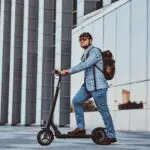The information in this guide is not intended to be legal advice. It is the current available information about existing federal laws, and some state and local electric bike laws are provided as examples and for research guidance. Anyone who owns an electric bike or wants to buy one should become familiar with relevant e bike laws before attempting to operate the bike on streets or highways.
Check out our legal guide to electric bikes in the USA to ensure you remain safe.
Federal Laws On Electric Bikes
There are several factors that determine how federal law classifies a lower-powered electric bike, which is called a “low-speed bike” in the United States Code.
According to 15 U.S.C. 2085, a low-speed electric bike is considered a consumer product for legal purposes.[1] It is subject to federal regulations that apply to consumer products. A low-speed bicycle is defined as a two-wheeled or three-wheeled vehicle with pedals that are fully operable and an electric motor that does not exceed 750 watts.
This section of the law goes on to include that the bike must also have a maximum speed under 20 mph when it is ridden by a person weighing 170 pounds.[1] If an electric bicycle has a higher speed limit, it is considered a motor vehicle and is regulated by the Department of Motor Vehicles.[2]
This also means there are different licensing rules and other regulations that apply to higher-powered electric bikes that do not qualify as consumer products.
State Laws
The PeopleForBikes Foundation provides a list links to current regulations for every state.[3] While federal laws mostly concern the classification of electric bikes, state laws are more focused on operational, licensing and safety measures.
Several states have enacted laws specifically about electric bicycles since about 2015. There are some important components that states focus on with e bike laws. They include the following:
- Revising old laws about scooters and mopeds.
- Reviewing registration, licensing and other requirements.
- Developing a multi-level system of classifying electric bikes based on speed potential.
- Revising recent laws that leave gaps or deficiencies in clarification.
With those points in mind, it helps to understand what topics states address when creating their own regulations. The following sections outline some important areas of consideration. These are all important to cover when researching individual state and local laws.
Type and Identification
Not all states consider electric bikes to be what federal law defines them as, and this may lead to confusion for some people who are still planning an initial purchase.
States usually identify an overall type, which is either bicycle or motorcycle. For further clarification and sorting, they may also use multiple identity categories, such as scooters, motor-assisted bicycles, electric bicycles or something else.
More than 30 states define electric bicycles to differentiate them from motorcycles for licensing or regulatory purposes. However, several states do not do this. For example, Alabama recognizes motorcycles and motor-driven cycles. With the exception of a restricted license option, motor-driven cycles are bound to nearly all the same operational laws as motorcycles.[4]
In some states, electric bikes are not subject to DMV registration since they are not considered motorcycles. For example, Colorado’s electric bike laws do not require scooters or electric bikes to be registered.[5]
Also, the state defines electric bikes in three separate classes to clarify the types of bike designs that are exempt. Class 1 applies to bikes that require pedaling, and the motor cannot exceed 20 mph. Class 2 applies to bikes that do not require pedaling, and the 20 mph speed limit also applies.
Class 3 applies to bikes that require pedaling assistance and do not exceed 28 mph, and such bikes must have a speedometer.[5] In states where DMV registration is required for motorcycles or motorized bikes, operators must carry their proof of registration when they drive their bikes.
Minimum Age
In some states, the minimum age may be lower or the same as the minimum age for driving or operating a motorcycle. However, some states may have special exceptions for motorized bikes.
For example, Alabama allows anyone who is at least 14 to obtain a restricted license only for a motor-driven cycle, and those who are 16 may obtain a Class M license for a motorcycle or a motor-driven cycle.[4] Alternately, although licenses are not required in Colorado, state law prohibits anyone under the age of 16 from operating a Class 3 electric bike.[5]
Driver’s License
Most states that require e bike riders to register their bikes like motorcycles also require a driver’s license or a permit to operate them. For example, as previously stated, a motor-driven cycle is treated like a motor vehicle in Alabama.
Those who operate one without a license can face legal penalties.[4] However, some states may only require an ID card instead of a driver’s license. Indiana is one example.
Some states have special exceptions, such as New Jersey. In New Jersey, the law does not classify an electric bike as a bicycle or a motorcycle. It is simply classified as a moped. A moped requires both DMV registration and a driver’s license.[6]
Liability Insurance
As it is with driver’s license requirements, some states that require registration of electric bikes also have insurance requirements for them.
New Jersey requires drivers to carry an insurance identification card while operating the electric bike, and failure to comply can result in a $50 fine.[6] Some states have very specific requirements. For example, Idaho has several categories for motorized bicycles with specific details to determine which ones require registration and insurance.
The first three classes of bikes do not require insurance. A bike in the “other” category that has 20″ or larger wheels, goes over 30 mph or meets other specific criteria requires registration and insurance.[7]
Speed Capability
Most states with differentiating laws stick to the federal guidelines for low-speed electric bikes, which say that the bikes cannot exceed 20 mph.
However, some states provide for special classes or higher classes in multi-tier systems, and those higher-powered bikes may be subject to special rules for a license, registration or insurance.
For example, while each of the three main classes of electric bikes are not subject to vehicle registration requirements in Idaho, Class 2 bikes must have an OHV sticker for off-highway use.[7] Class 1 and Class 3 e bikes are not required to have a sticker for off-highway use.
Maximum Power
Most states have a set of classification criteria that include a maximum power for the motor of the bicycle. While many states set the limit at 750 watts, others list different allowances. For example, the state of Kansas has a maximum power limit of 1,000 watts for a bike to classified as an electric bicycle.[8] However, like many other states that follow federal guidelines, the state limits the maximum speed for such a bike to 20 mph.
Alternately, for Idaho’s “other” class that requires insurance and registration, the state includes most motorized bikes that have more than 750 watts of power.[7]
Helmet Use
Some states, such as Maryland and Nebraska, have universal helmet requirements for all drivers of motorized bikes. However, many states that have helmet laws apply them to specific age groups. For example, in California, anyone who is under the age of 18 must wear a helmet while riding an electric bike.[9]
People who are over the age of 18 do not need to wear a helmet. In some states, there are general rules that may not apply to all cities or areas, which is why local laws are also important to research.
Roadway Rules
Electric bike owners must also learn the rules of the road for cyclists or motorcyclists that relate to state laws and classification of e bikes. For example, it is important to know when it is acceptable to take the entire lane or stay to the right side of the road.
In Texas, people riding motorized bicycles are not supposed to take an entire lane unless they are preparing to turn left, passing a vehicle that is traveling in the same direction or are experiencing certain difficulties.[10]
City Laws
Many cities or jurisdictions have their own regulations for what electric bicycles can or cannot do. Some cities may have their own regulations for helmets or other safety aspects that conflict with state laws.
Virginia is an example. In Virginia, anyone who is under the age of 16 must wear a helmet, and several jurisdictions also require all bicycle drivers or passengers who are under the age of 14 to use a helmet.[11]
One common question that people ask about city laws is if riding an electric bike on sidewalks is legal. They often look to state laws, which can be confusing. Some states, such as Texas, do not have laws that specifically prohibit electric bikes or bicycles from being on sidewalks.[10].
Some people may mistakenly think that it is acceptable to ride on their local sidewalks and can wind up with a ticket in some places. In many cities, there are local codes or ordinances that make it illegal to ride any type of bicycle on the sidewalks. Some cities have bike lanes or shared lanes for sharing the road with motor vehicles.
Not all cities prohibit motorized bikes from sidewalks and multi-use paths. For example, the Arizona city of Scottsdale permits Class 1 and Class 2 motorized bikes to use sidewalks and multipurpose paths.[12]
These two classes are limited to electric bicycles that cannot exceed 20 mph. However, the city also added that while such bikes can use regular sidewalks, they are never permitted to operate on the covered sidewalks in Old Town Scottsdale.
Another issue that often affects local governments is how electric bikes are parked when they are not in use. In some larger cities, these bikes have skyrocketed in popularity.
In some cases, this increased popularity has led to sidewalks being blocked with parked electric bikes or hard-to-find parking spaces being taken improperly. Many people do not know how or where to park their electric bikes, and it is a problem that some cities are still trying to figure out.
San Francisco is one example of a city that has a lot of e bike users, and the city now has a detailed set of ordinances that specifically address how to park electric bikes.
According to city rules, e bikes cannot be parked in any way in which they hamper access to streets, sidewalks, courts, alleys, lanes or other places.[13] In smaller cities where motorized bikes are less popular, there may not be any specific local rules for them.
How to Find and Follow Applicable Laws
Electric bike riders or aspiring owners can learn all applicable laws by checking for state-specific information from the state or from an electric bike association.[3]
When checking for state information, the first step is to find out if electric bikes are classified as bicycles, motorcycles or something else. In most cases, owners of bikes that are classified as motorcycles can find more in-depth information from the state’s DMV website.
The state’s transportation authority or DOT may have more information about electric bike regulations in places where electric bikes are defined in multiple classes.
After finding state information about e bike laws, owners can learn if there are requirements for carrying a driver’s license, obtaining insurance or having the bike registered. For information about local regulations, electric bike owners can contact the police department.
The next step is to find all applicable local and state operational rules, such as helmet requirements or other safety requirements. Some states require DOT-compliant helmets. While helmets are not part of the electric bike laws in every state, they are strongly recommended to protect even slow-moving bike riders of all ages from unexpected falls or the actions of careless vehicle drivers on the road.
Since e bikes are evolving and growing in popularity, owners should frequently check to see if there are new city or state legal updates.
References:
[1]https://www.govinfo.gov/content/pkg/USCODE-2011-title15/pdf/USCODE-2011-title15-chap47-sec2085.pdf
[2]https://www.congress.gov/107/plaws/publ319/PLAW-107publ319.pdf
[3]https://peopleforbikes.org/our-work/e-bikes/policies-and-laws/
[4] https://www.alea.gov/sites/default/files/inline-files/motorcyclemanual_0.pdf
[5] https://leg.colorado.gov/content/electric-bicycles
[6] https://www.state.nj.us/mvc/pdf/license/mopedman.pdf
[7] https://itd.idaho.gov/wp-content/uploads/2019/01/2-Wheel_and_3-Wheel_Vehicle_Requirements.pdf
[8] https://law.justia.com/codes/kansas/2016/chapter-8/article-14/section-8-1489
[9] http://leginfo.legislature.ca.gov/faces/codes_displaySection.xhtml?sectionNum=21212.&lawCode=VEH
[10] https://www.txdot.gov/inside-txdot/modes-of-travel/bicycle/know/laws.html
[11]https://www.virginiadot.org/programs/bikeped/laws_and_safety_tips.asp#Helmetuse
[12] https://www.scottsdaleaz.gov/codes/bike-scooters
[13] https://www.sfmta.com/sites/default/files/reports-and-documents/2019/07/appendix_1_-_powered_scooter_parking_requirements.pdf





